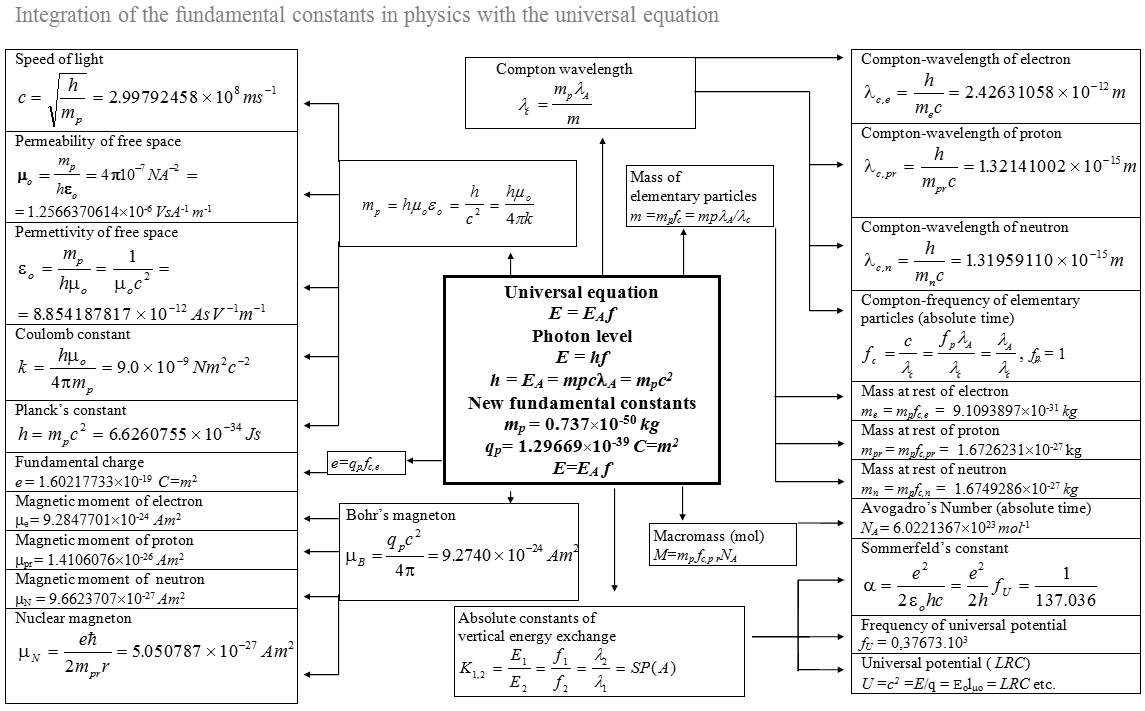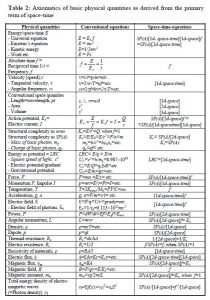by Georgi Alexandrov Stankov
Copyright 1999, 52 pages
abstract
In 1995, I discovered the Universal Law (the Law) of Nature: I proved that all known physical laws and their applications can be derived from this one law within mathematical formalism and can be explained for the first time from an epistemological and cognitive point of view. The discovery of the Law is the logical result of the consistent implementation of the principles of mathematical formalism to the structure of present-day physics. This endeavour has led to the development of a unified theory of physics and cosmology, which is a full axiomatisation (axiomatics) of physics. It could be shown that physics is applied mathematics to the physical world. The major results of the new theory are: All terms, quantities, constants, and other physical magnitudes can be axiomatically derived from the primary term, energy = space-time, which is the primary term of human consciousness. The primary axiom of the new axiomatics establishes the semantic and mathematical equivalence between all words or abstract symbols that can be arbitrarily used for the primary term. This is called the „principle of last equivalence“; it is the first and only a priori axiom of the new integrated physical and mathematical axiomatics. According to it, energy (space-time) is closed, infinite, continuous, inhomogeneous (discrete), and constant; it is in a state of permanent energy exchange. It can be proven that the continuum (the set of all numbers) is equivalent to the primary term. Therefore, it is the common basis of both physics and mathematics. The new axiomatics is verified by all mathematical (numerical) results that have been theoretically or experimentally obtained in physics so far. However, it eliminates some fundamental formalistic blunders that have been introduced in this natural science throughout its history by implementing the principles of mathematical formalism in an inconsistent, and hence, wrong manner. In this way, the validity of mathematics as challenged by Gödel’s theorem can be proven in the real world (proof of existence). This eliminates the continuum hypothesis and the ongoing foundation crisis of mathematics as artifacts that are based on wrong assumptions.
The Universal Law describes space-time in mathematical terms. The universal equation is E = EAf, where E is energy exchange, EA is a specific constant amount (quantum) of exchanged energy, called “action potential“, and f = E/EA is called „absolute time“. The latter is a dimensionless quotient. The Universal Law is a law of energy. Energy (space-time) is the only real thing. All physical quantities such as mass, charge, force, and momentum are abstract subsets of space-time that are first defined within mathematics (objects of thought) and are then measured in the real world. They are dimensionless numbers that belong to the continuum. Since they contain space-time as an element (U-subsets), they can be axiomatically derived from the primary term. For instance, it can be proven in an irrevocable manner that mass, as it is currently defined in physics, is actually a synonym for energy (space-time) relationship, and charge is a synonym for area (two-dimensional space), that is, the SI unit 1 coulomb is equivalent to 1m2. Therefore, photons are not mass-less particles, as is believed in physics today, but exhibit energy relationships (masses), just as all other material systems such as gravitational objects. By eliminating such fundamental formalistic blunders in physics, gravitation can be integrated for the first time with the other three fundamental forces. At the same time, it can be cogently proven that the big-bang-hypothesis, and hence all the basic concepts of modern cosmology, are entirely wrong. The new theory is outlined in two comprehensive volumes of more than 1000 pages and encompasses the full axiomatic presentation of the fundamental physical disciplines. The present publication summarizes the basic axioms and conclusions of the new integrated physical and mathematical theory of the Law.
Key words: Universal Law, universal equation, primary term, space-time, energy, integrated physical and mathematical axiomatics, mathematical formalism, space, absolute time f, primary axiom, continuum, probability set, epistemology of mathematical equations.
introduction
Since Einstein, it has been the dream of many physicists to discover the „universal field equation“ and derive all known laws from the same. Contrary to this endeavour, modern physics teaches that nature is regulated by many distinct physical laws. They are products of various disciplines, such as classical mechanics, thermodynamics, wave theory, electromagnetism, quantum mechanics, theory of relativity, QED, QCD, etc. We encounter various laws, the most prominent of which are: Newton’s axioms of classical mechanics, his law on gravity, Kepler’s laws, the first and second law of thermodynamics, Boltzmann’s law, laws of radiation (Wien’s displacement law, Stefan-Boltzmann’s law), classical wave equation, various laws of electricity and magnetism, which can be regarded as precursors of Maxwell’s four equations of electromagnetism, Schrödinger wave equation of quantum mechanics, etc. Unfortunately, physicists have failed to explain why Nature needs so many laws, and how it co-ordinates them in a simultaneous manner so that it functions as an ordered whole. The new axiomatic approach in physics proves that these different laws are, from an ontological point of view, equivalent mathematical presentations of one single law of nature – they are derivations of the Universal Law for specific energy interactions. This extensive proof forms the basis of the new unified theory of physics and cosmology, which adheres to the principles of mathematical formalism (see Tables 1 & 2 below).
Although the necessity of axiomatizing physics on the basis of mathematical formalism was postulated some time ago (1), this target has not yet been achieved. The discovery of the Universal Law of Nature has led to the establishment of a general theory of physics and cosmology, which is an axiomatization of physics on the basis of mathematical formalism (2-5). It confirms without any exception all the mathematical (theoretical) and experimental results obtained in physics so far. At the same time, it reveals that some basic verbal interpretations of these results are essentially wrong from an epistemological point of view. Such mistaken conclusions have precluded the unification of physics. The major results of the new integrated physical and mathematical axiomatics can be summarized as follows:
1. Energy (space-time) has only two dimensions (constituents), space and absolute time. They are canonically conjugated reciprocal magnitudes that can be expressed as numerical, dimensionless relationships. All physical quantities as measured by the SI system can be derived from these two quantities (see Table 2). This proves that the SI system is an anthropocentric surrogate and should be abolished from theoretical physics.
2. There is no vacuum. There are instead photons (photon level) perceived as space (extent). The photon level has the same properties as matter, for instance, it can be assessed in terms of mass (space-time relationship) and charge (area). Two new fundamental constants have been derived: mass mp = 0.737´10-50 kg and charge qp=1.29669´10-39m2 of the basic photon h, also known as Planck’s constant.
3. All known physical constants can be derived from these two constants by applying the universal equation (see Table 1). Thus the energy (space-time) of the basic photon h is the hidden real reference system of SI system, from which all other SI units and quantities are obtained in a secondary manner according to the principle of circular argument. This is basic proof that the physical world is a unity.
4. A novel method has been developed, which enables the derivation of many new physical constants within mathematical formalism and their empirical verification by various well-known experiments. All natural constants are dimensionless numbers – their magnitudes are independent of the choice of the surrogate reference system such as the SI system – therefore, the SI system should be eliminated from theoretical physics.
5. Charge is a synonym for geometric area: 1 coulomb = 1 square meter.
6. The basic terms – time, temperature, and relativistic mass – are dimensionless numbers (quotients), the definition of which is mathematics. They are physical sets of the probability set (0≤P(A)≤1) as introduced by Kolmogoroff in his theory of probabilities. The probability set is equivalent to the primary term P(A) = n = space-time = energy.
7. The standard model of cosmology (the hot big bang hypothesis) must be refuted – the universe does not expand. Instead, there is an incessant exchange of energy (and mass) between photons and matter. This exchange is responsible for gravitation, as has been confirmed by the discovery of many new cosmological constants. With the help of these new constants, gravitation can be integrated for the first time with electromagnetism and the other two fundamental forces. These constants build a numerical input-output model of the universe. This model is equivalent to the continuum.
8. The standard model of physics must be refuted in its reductional attempt to explain nature on the basis of a few elementary particles. At the same time, the new theory confirms all the mathematical results obtained in QED and QCD.
9. Although the various mathematical expressions of the second law of thermodynamics are derivations of the universal equation, the notion of growing entropy in the universe as stated by this law must be rejected.
*
The extensive mathematical proofs of these results are given in volume I and volume II (2-4), which take due account of the basis of modern physics and cosmology. The new integrated physical and mathematical axiomatics follows the principle of inner consistency and lack of contradictions. Therefore, it would be sufficient to reject only one of the aforementioned results to renounce the existence of the Law. However, this is not possible.
Table 1:



